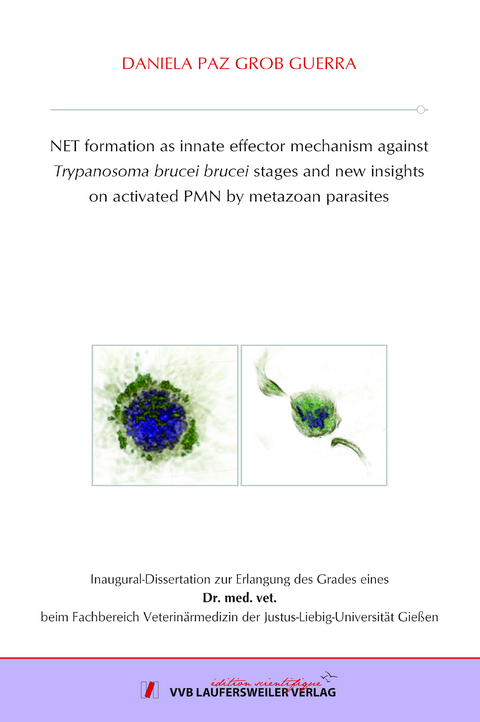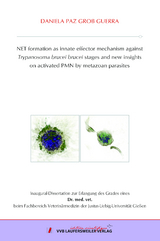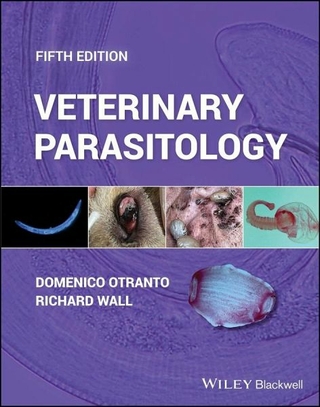NET formation as innate effector mechanism against Trypanosoma brucei brucei stages and new insights on activated PMN by metazoan parasites
Seiten
2023
VVB Laufersweiler Verlag
978-3-8359-7105-9 (ISBN)
VVB Laufersweiler Verlag
978-3-8359-7105-9 (ISBN)
- Keine Verlagsinformationen verfügbar
- Artikel merken
Polymorphkernige Neutrophile (PMN) sind die am häufigsten vorkommenden Leukozyten in Lymphe sowie im Blut. Sie werden schnell aus dem Blutkreislauf an Infektionsstellen rekrutiert, um dort Krankheitserreger zu bekämpfen. So reagieren PMN auf protozoäre und metazoische Parasiten durch folgende Effektormechanismen: Freisetzung von immunmodulatorischen Molekülen (d. h. Zytokinen und Chemokinen), Phagozytose, Produktion von reaktiven Sauerstoffspezies (ROS) und der Freisetzung von neutrophilen extrazellulären Traps (NETs). NETs wurden als feine extrazelluläre Strukturen beschrieben, die aus dekondensiertem Chromatin bestehen und mit antimikrobiellen Komponenten wie Myeloperoxidase (MPO), Neutrophiler Elastase (NE), Lactoferrin, Calprotein, LL37, Pentraxin, Proteinase 3 oder Cathepsin G vesehen sind. Es wurden bereits mehrere Parasitenarten als Induktoren von NETs beschrieben, darunter unter anderem Besnoitia besnoiti, Neospora caninum und Dirofilaria immitis. Die vorliegende Dissertation thematisiert weitere relevante Parasiten, wie z.B. die Blutstromparasiten Trypanosoma brucei brucei und Angiostrongylus vasorum. Dabei sind folgende Ergebnisse besonders hervorzuheben:
Die Kokultur von Rinder-PMN mit T. b. brucei-Stadien, d.h. prozyklische Trypomastigoten und metazyklische Blutkreislauf-Trypomastigoten, führten zu einer starken NET-Freisetzung und PMN-Aktivierung. Dieser Prozess war unabhängig von Zeitpunkt und Parasitenstadium. Bei Konfrontation von vitalen T. b. brucei-Stadien mit Rinder-PMN wurde eine schnelle und anhaltende Erhöhung der Sauerstoffverbrauchsrate (OCR) und der extrazellulären Ansäuerungsrate (ECAR) erreicht, was auf eine Produktion von ROS als Reaktion auf den Parasiten hindeutet. Des Weiteren wurden NET-Strukturen durch SEM-Bilder, konfokale Laserscanmikroskopie und holotomographische 3D-Mikroskopie-Analysen lebender Zellen visualisiert. Diese zeigen die Ko-Lokalisierung von DNA mit antimikrobiellen Molekülen, die im PMN-Kern und -Granula vorhanden sind. Dabei konnten Histone (H1, H2A/H2B, H3, H4) und Neutrophile Elastase als klassische Komponenten der extrazellulären Abwehrstrukturen dargestellt werden. Darüber hinaus wurden morphologische Veränderungen in der Ausdehnung des Kernbereichs von Rinder-PMN als Folge der Chromatin-Dekondensation beobachtet. Hier wurde eine Analyse von Fluoreszenzmikroskopie-Bildern durchgeführt, wobei eine halbautomatische Quantifizierung der NETs-Bildung angewendet wurde, die als „DNA-Bereichs- und NETosis-Analyse“ (DANA) bezeichnet wird.
Darüber hinaus wurde eine Bewertung verschiedener Phänotypen von NETs durchgeführt, die zeigte, dass die Bildung von aggNETs der am häufigsten vorkommende Phänotyp war, wenn
Rinder-PMN mit T. b. brucei prozyklische Trypomastigoten und metazyklische Trypomastigoten konfrontiert wurden. Dieses Ergebnis war unabhängig vom Zeitpunkt und von dem PMN/Parasiten-Verhältnis.
Um die Beteiligung purinerger Rezeptoren an der Aktivierung von Rinder-PMN und an der Bildung von aggNETs zu untersuchen, wurden die purinergen Inhibitoren NF449 (Antagonist des P2X1-Rezeptors) und MRS2578 (Antagonist des P2Y6-Rezeptors) getestet. In diesem Zusammenhang enthüllte NF449 bei 100 µM und 10 µM eine inhibitorische Wirkung, was die spezifische Rolle von P2X1 in T. b brucei-vermittelter NETose widerspiegelt. Die Wirkung von MRS2578 wurde bei 10 µM bestätigt, was eine Rolle von P2Y6 in diesem Prozess beweist. Diese Ergebnisse wurden erzielt, indem die Hemmung der Bildung von aggNETs mit Bildanalysen und OCR-Messungen in Rinder-PMN untersucht wurde.
Hunde-PMN wurden mit vitalen A. vasorum-L3 stimuliert und die Veränderungen in der NAE der Zellen und der NET-Bildung analysiert. Dabei war sprNETs der am häufigsten vorkommende Phänotyp. Nach der Stimulation von Endothelzellen der Aorta des Hundes (CAEC) durch lösliches Antigen von A. vasorum (AvAg) wurde deren Aktivierung durch Messungen klassischer Adhäsionsmoleküle, einschließlich P-Selectin, E-Selectin, VCAM-1 und ICAM-1, bestätigt.
Zusätzlich konnte eine Endothelzellschädigung beim Wirt nachgewiesen werden, die durch NETs und H2A durch Aktivierung von B. besnoiti-Tachyzoiten, ausgelöst wurde. Dies bestätigt die von NETs stammenden schädlichen Wirkungen auf mit B. besnoiti infizierte BUVEC-Monolayer unter physiologischen Bedingungen.
Es wurden hier Experimente mit Kolostrum-PMN von Hündinnen durchgeführt, wobei beobachtet wurde, dass Hunde-Kolostral-PMN in der Lage sind, NETs gegen vitale sowie tote N. caninum-Tachyzoiten zu bilden. Des Weiteren konnte die phagozytische Funktion von Kolostral-PMN bei Neugeborenen gezeigt werden.
Schließlich wurden Experimente mit Rinder-PMN gegen S. scabiei-Stadien (Adulte, Nymphen, Larven und Eier) sowie lösliches S. scabiei-Antigen (ScAg) durchgeführt. Dabei konnte eine leichte Anheftung von PMN an das Exoskelett von S. scabiei-Stadien beobachtet werden. Es wurde jedoch nach Stimulation von Rinder-PMN mit 10 µM ScAg nur eine schwache NET-Produktion erreicht. Phagozytose, ROS-Produktion und Ca++-Flüsse konnten nach der Stimulierung mit 10 µM ScAg beobachtet werden. Insgesamt belegen die präsentierten Daten, dass nicht alle Parasiten NETose in gleicher Art und Weise induzieren können, weshalb zukünftige Arbeiten im Bereich Modulations- sowie Evasionsstrategien des angeborenen Immunsystems auf Parasiten erforderlich sind. Polymorphonuclear neutrophils (PMN) have been described as the most abundant leukocyte in lymph and bloodstream, being rapidly recruited from circulation to sites of infection to fight against foreign pathogens. PMN reacts against protozoan and metazoan parasites by different effector mechanisms, including the release of immunomodulatory molecules (i. e. cytokines and chemokines), phagocytosis, production of reactive oxygen species (ROS), and release of neutrophil extracellular traps (NETs). NETs have been described as a delicate extracellular structure formed by decondensed chromatin and adorned with antimicrobial components, such as myeloperoxidase (MPO), neutrophil elastase (NE), lactoferrin, calprotein, LL37, pentraxin, proteinase 3 or cathepsin G. In this sense, several protozoan and metazoan parasite species have been described as inducers of NETs, including Besnoitia besnoiti, Neospora caninum and Dirofilaria immitis, among others. A close interaction between members of these groups were here studied, specifically in the case of the bloodstream parasites Trypanosoma brucei brucei and Angiostrongylus vasorum. In this sense, the main findings in the current work are:
Co-culture of bovine PMN with T. b. brucei stages, i. e. procyclic trypomastigotes and bloodstream metacyclic trypomastigotes, resulted in strong NETs release and PMN activation, independent of the time-point and parasitic stage. A fast and sustained increase in time of oxygen consumption rates (OCR) and extracellular acidification rates (ECAR) was achieved, when live T. b. brucei stages were confronted with bovine PMN, suggesting that ROS production might be caused as a response against the parasite. NET structures where visualized by SEM pictures, laser scanning confocal microscopy and live cell 3D-holotomographic microscopy analyzes, unveiling the co-localization of DNA with antimicrobial molecules present in PMN nucleus and granules, such as histones (H1, H2A/H2B, H3, H4) and neutrophil elastase, confirming the classical components of these extracellular defense structures. Moreover, morphological changes in expansion of nuclear area from bovine PMN were observed, as a consequence of chromatin decondensation. Analysis of fluorescence microscopy-derived images was here performed, applying a semi-automatic quantification of NETs formation called ‘DNA area and NETosis analysis’ (DANA).
Assessment of different phenotypes of NETs was performed, proving that the formation of aggNETs was the most abundant phenotype present, when bovine PMN where stimulated with T. b. brucei procyclic trypomastigotes and metacyclic trypomastigotes, independent of the time-point and PMN : parasite ratio.
Regarding the participation of purinergic receptors in activation of bovine PMN and aggNETs formation, the purinergic inhibitors NF449 (antagonist of P2X1 receptor) and MRS2578 (antagonist of P2Y6 receptor) were tested. In this context, NF449 at 100 µM and 10 µM unveiled the inhibitory effect, proving a specific role for the P2X1 in T. b. brucei-mediated NETosis. Thus, the effect of MRS2578 at 10 µM was confirmed, verifying a role of the P2Y6 in this process. These results were achieved by confirming the inhibition of aggNETs formation with images analyzes and measurements of OCR in bovine PMN.
Canine PMN were stimulated with vital A. vasorum L3, observing changes in the NAE of the cells and NETs formation, being sprNETs the most abundant phenotype. Interestingly, after stimulation with A. vasorum soluble antigen (AvAg), activation of canine aortic endothelial cells (CAEC) was confirmed, by measurements of classical adhesion molecules, including P-selectin, E-selectin, VCAM-1 and ICAM-1. In this line, host endothelial cell damage triggered by B. besnoiti tachyzoites isolated NETs and H2A was demonstrated, confirming NETs-derived adverse effects against BUVEC-monolayers infected with B. besnoiti, under physiological flow conditions.
Remarkably, experiments with colostrum PMN from bitches were here performed, observing that canine colostral PMN are able to cast NET against vital and dead N. caninum tachyzoites. Even so, the ability of colostral PMN to perform its phagocytic function in neonates was also here achieved.
Lastly, experiments of bovine PMN against S. scabiei stages (adults, nymphs, larvae and eggs) and soluble S. scabiei antigen (ScAg) were performed, proving a slight attachment of PMN to the exoskeleton of S. scabiei stages. However, after stimulation of bovine PMN with 10 µM ScAg, a weak NETs production was achieved. Notably, phagocytosis, ROS production and Ca++ fluxes were observed, after stimulation with 10 µM ScAg. Overall, presented data evidence that not all parasites can induce NETosis and therefore demanding future work on modulation or evasion strategies of this innate effector process by parasites.
Die Kokultur von Rinder-PMN mit T. b. brucei-Stadien, d.h. prozyklische Trypomastigoten und metazyklische Blutkreislauf-Trypomastigoten, führten zu einer starken NET-Freisetzung und PMN-Aktivierung. Dieser Prozess war unabhängig von Zeitpunkt und Parasitenstadium. Bei Konfrontation von vitalen T. b. brucei-Stadien mit Rinder-PMN wurde eine schnelle und anhaltende Erhöhung der Sauerstoffverbrauchsrate (OCR) und der extrazellulären Ansäuerungsrate (ECAR) erreicht, was auf eine Produktion von ROS als Reaktion auf den Parasiten hindeutet. Des Weiteren wurden NET-Strukturen durch SEM-Bilder, konfokale Laserscanmikroskopie und holotomographische 3D-Mikroskopie-Analysen lebender Zellen visualisiert. Diese zeigen die Ko-Lokalisierung von DNA mit antimikrobiellen Molekülen, die im PMN-Kern und -Granula vorhanden sind. Dabei konnten Histone (H1, H2A/H2B, H3, H4) und Neutrophile Elastase als klassische Komponenten der extrazellulären Abwehrstrukturen dargestellt werden. Darüber hinaus wurden morphologische Veränderungen in der Ausdehnung des Kernbereichs von Rinder-PMN als Folge der Chromatin-Dekondensation beobachtet. Hier wurde eine Analyse von Fluoreszenzmikroskopie-Bildern durchgeführt, wobei eine halbautomatische Quantifizierung der NETs-Bildung angewendet wurde, die als „DNA-Bereichs- und NETosis-Analyse“ (DANA) bezeichnet wird.
Darüber hinaus wurde eine Bewertung verschiedener Phänotypen von NETs durchgeführt, die zeigte, dass die Bildung von aggNETs der am häufigsten vorkommende Phänotyp war, wenn
Rinder-PMN mit T. b. brucei prozyklische Trypomastigoten und metazyklische Trypomastigoten konfrontiert wurden. Dieses Ergebnis war unabhängig vom Zeitpunkt und von dem PMN/Parasiten-Verhältnis.
Um die Beteiligung purinerger Rezeptoren an der Aktivierung von Rinder-PMN und an der Bildung von aggNETs zu untersuchen, wurden die purinergen Inhibitoren NF449 (Antagonist des P2X1-Rezeptors) und MRS2578 (Antagonist des P2Y6-Rezeptors) getestet. In diesem Zusammenhang enthüllte NF449 bei 100 µM und 10 µM eine inhibitorische Wirkung, was die spezifische Rolle von P2X1 in T. b brucei-vermittelter NETose widerspiegelt. Die Wirkung von MRS2578 wurde bei 10 µM bestätigt, was eine Rolle von P2Y6 in diesem Prozess beweist. Diese Ergebnisse wurden erzielt, indem die Hemmung der Bildung von aggNETs mit Bildanalysen und OCR-Messungen in Rinder-PMN untersucht wurde.
Hunde-PMN wurden mit vitalen A. vasorum-L3 stimuliert und die Veränderungen in der NAE der Zellen und der NET-Bildung analysiert. Dabei war sprNETs der am häufigsten vorkommende Phänotyp. Nach der Stimulation von Endothelzellen der Aorta des Hundes (CAEC) durch lösliches Antigen von A. vasorum (AvAg) wurde deren Aktivierung durch Messungen klassischer Adhäsionsmoleküle, einschließlich P-Selectin, E-Selectin, VCAM-1 und ICAM-1, bestätigt.
Zusätzlich konnte eine Endothelzellschädigung beim Wirt nachgewiesen werden, die durch NETs und H2A durch Aktivierung von B. besnoiti-Tachyzoiten, ausgelöst wurde. Dies bestätigt die von NETs stammenden schädlichen Wirkungen auf mit B. besnoiti infizierte BUVEC-Monolayer unter physiologischen Bedingungen.
Es wurden hier Experimente mit Kolostrum-PMN von Hündinnen durchgeführt, wobei beobachtet wurde, dass Hunde-Kolostral-PMN in der Lage sind, NETs gegen vitale sowie tote N. caninum-Tachyzoiten zu bilden. Des Weiteren konnte die phagozytische Funktion von Kolostral-PMN bei Neugeborenen gezeigt werden.
Schließlich wurden Experimente mit Rinder-PMN gegen S. scabiei-Stadien (Adulte, Nymphen, Larven und Eier) sowie lösliches S. scabiei-Antigen (ScAg) durchgeführt. Dabei konnte eine leichte Anheftung von PMN an das Exoskelett von S. scabiei-Stadien beobachtet werden. Es wurde jedoch nach Stimulation von Rinder-PMN mit 10 µM ScAg nur eine schwache NET-Produktion erreicht. Phagozytose, ROS-Produktion und Ca++-Flüsse konnten nach der Stimulierung mit 10 µM ScAg beobachtet werden. Insgesamt belegen die präsentierten Daten, dass nicht alle Parasiten NETose in gleicher Art und Weise induzieren können, weshalb zukünftige Arbeiten im Bereich Modulations- sowie Evasionsstrategien des angeborenen Immunsystems auf Parasiten erforderlich sind. Polymorphonuclear neutrophils (PMN) have been described as the most abundant leukocyte in lymph and bloodstream, being rapidly recruited from circulation to sites of infection to fight against foreign pathogens. PMN reacts against protozoan and metazoan parasites by different effector mechanisms, including the release of immunomodulatory molecules (i. e. cytokines and chemokines), phagocytosis, production of reactive oxygen species (ROS), and release of neutrophil extracellular traps (NETs). NETs have been described as a delicate extracellular structure formed by decondensed chromatin and adorned with antimicrobial components, such as myeloperoxidase (MPO), neutrophil elastase (NE), lactoferrin, calprotein, LL37, pentraxin, proteinase 3 or cathepsin G. In this sense, several protozoan and metazoan parasite species have been described as inducers of NETs, including Besnoitia besnoiti, Neospora caninum and Dirofilaria immitis, among others. A close interaction between members of these groups were here studied, specifically in the case of the bloodstream parasites Trypanosoma brucei brucei and Angiostrongylus vasorum. In this sense, the main findings in the current work are:
Co-culture of bovine PMN with T. b. brucei stages, i. e. procyclic trypomastigotes and bloodstream metacyclic trypomastigotes, resulted in strong NETs release and PMN activation, independent of the time-point and parasitic stage. A fast and sustained increase in time of oxygen consumption rates (OCR) and extracellular acidification rates (ECAR) was achieved, when live T. b. brucei stages were confronted with bovine PMN, suggesting that ROS production might be caused as a response against the parasite. NET structures where visualized by SEM pictures, laser scanning confocal microscopy and live cell 3D-holotomographic microscopy analyzes, unveiling the co-localization of DNA with antimicrobial molecules present in PMN nucleus and granules, such as histones (H1, H2A/H2B, H3, H4) and neutrophil elastase, confirming the classical components of these extracellular defense structures. Moreover, morphological changes in expansion of nuclear area from bovine PMN were observed, as a consequence of chromatin decondensation. Analysis of fluorescence microscopy-derived images was here performed, applying a semi-automatic quantification of NETs formation called ‘DNA area and NETosis analysis’ (DANA).
Assessment of different phenotypes of NETs was performed, proving that the formation of aggNETs was the most abundant phenotype present, when bovine PMN where stimulated with T. b. brucei procyclic trypomastigotes and metacyclic trypomastigotes, independent of the time-point and PMN : parasite ratio.
Regarding the participation of purinergic receptors in activation of bovine PMN and aggNETs formation, the purinergic inhibitors NF449 (antagonist of P2X1 receptor) and MRS2578 (antagonist of P2Y6 receptor) were tested. In this context, NF449 at 100 µM and 10 µM unveiled the inhibitory effect, proving a specific role for the P2X1 in T. b. brucei-mediated NETosis. Thus, the effect of MRS2578 at 10 µM was confirmed, verifying a role of the P2Y6 in this process. These results were achieved by confirming the inhibition of aggNETs formation with images analyzes and measurements of OCR in bovine PMN.
Canine PMN were stimulated with vital A. vasorum L3, observing changes in the NAE of the cells and NETs formation, being sprNETs the most abundant phenotype. Interestingly, after stimulation with A. vasorum soluble antigen (AvAg), activation of canine aortic endothelial cells (CAEC) was confirmed, by measurements of classical adhesion molecules, including P-selectin, E-selectin, VCAM-1 and ICAM-1. In this line, host endothelial cell damage triggered by B. besnoiti tachyzoites isolated NETs and H2A was demonstrated, confirming NETs-derived adverse effects against BUVEC-monolayers infected with B. besnoiti, under physiological flow conditions.
Remarkably, experiments with colostrum PMN from bitches were here performed, observing that canine colostral PMN are able to cast NET against vital and dead N. caninum tachyzoites. Even so, the ability of colostral PMN to perform its phagocytic function in neonates was also here achieved.
Lastly, experiments of bovine PMN against S. scabiei stages (adults, nymphs, larvae and eggs) and soluble S. scabiei antigen (ScAg) were performed, proving a slight attachment of PMN to the exoskeleton of S. scabiei stages. However, after stimulation of bovine PMN with 10 µM ScAg, a weak NETs production was achieved. Notably, phagocytosis, ROS production and Ca++ fluxes were observed, after stimulation with 10 µM ScAg. Overall, presented data evidence that not all parasites can induce NETosis and therefore demanding future work on modulation or evasion strategies of this innate effector process by parasites.
| Erscheinungsdatum | 16.03.2023 |
|---|---|
| Reihe/Serie | Edition Scientifique |
| Verlagsort | Gießen |
| Sprache | englisch |
| Maße | 155 x 215 mm |
| Gewicht | 300 g |
| Themenwelt | Veterinärmedizin ► Allgemein |
| Veterinärmedizin ► Klinische Fächer ► Parasitologie | |
| Schlagworte | net • Parasiten • PMN • Tiere • Trypanosoma |
| ISBN-10 | 3-8359-7105-0 / 3835971050 |
| ISBN-13 | 978-3-8359-7105-9 / 9783835971059 |
| Zustand | Neuware |
| Informationen gemäß Produktsicherheitsverordnung (GPSR) | |
| Haben Sie eine Frage zum Produkt? |
Mehr entdecken
aus dem Bereich
aus dem Bereich
Buch | Spiralbindung (2023)
Schlütersche (Verlag)
179,00 €




